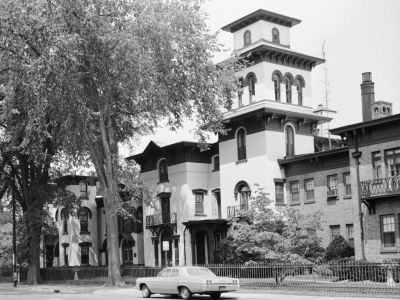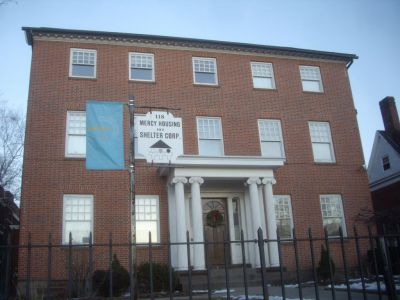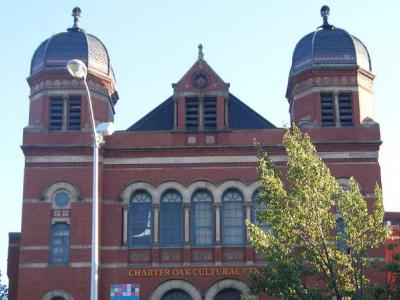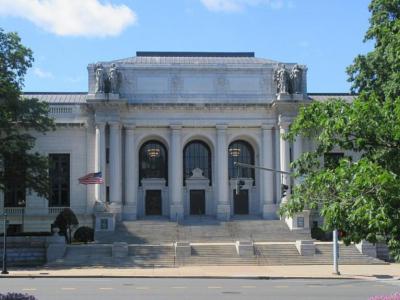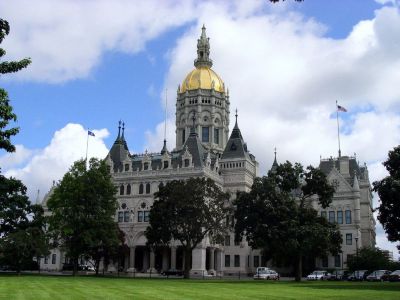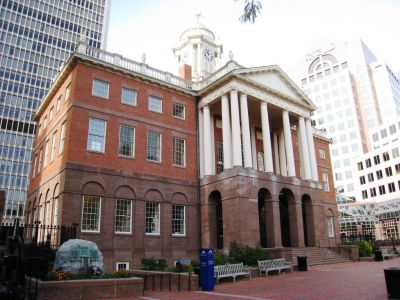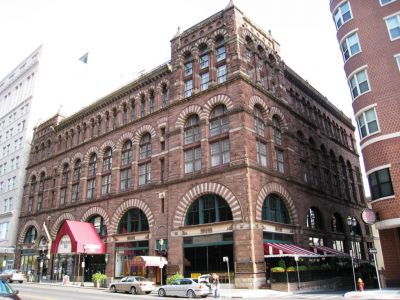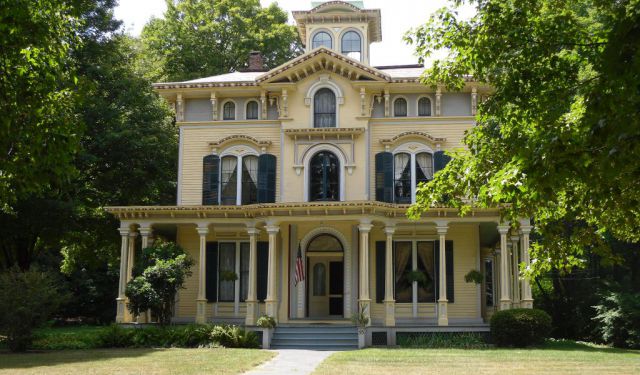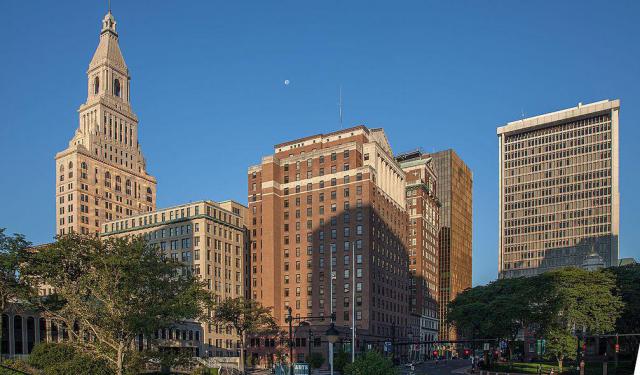Architectural Jewels (Self Guided), Hartford
Hartford, Connecticut abounds in one-of-a-kind, artistically unique structures – homes, museums, libraries, and government halls – each with a distinctive look, appeal, and history of their own. Some of them are celebrated works by well-known architects, and display a variety of styles.
Among these jewels is Armsmear, a historic mansion originally built for Samuel Colt, the famed inventor and industrialist in the second half of the 19th century. Its grandiose Italian villa architecture and opulent interiors showcase the wealth and sophistication of the era.
The Henry Barnard House stands as a testament to Georgian-era elegance. Named after Henry Barnard, a pioneering educator, this charming residence now functions as a homeless shelter under the ownership of a religious charity, offering a glimpse into the refined lifestyle of the past.
Temple Beth Israel, with its striking Romanesque Revival architecture, is a symbol of religious diversity and architectural innovation in Hartford. The city's oldest purpose-built synagogue, it has been rescued from demolition and today represents a vital preservation of local Jewish heritage.
Connecticut's State Library and the Connecticut State Capitol are architectural marvels that embody the state's commitment to knowledge and governance. The State Library's neoclassical design exudes a sense of grandeur, while the Capitol building's imposing dome and majestic façade command attention and reverence.
The Old State House, a historic landmark dating back to the late 18th century, is a gem of Federal architecture. Its iconic red brick exterior and stately columns serve as a reminder of Hartford's role in shaping the nation's history.
The Cheney Building, with its elegant Richardsonian style, represents Hartford's industrial heritage and entrepreneurial spirit. This historic commercial building features distinctive architectural elements reflecting the air of the 1870s.
To truly appreciate Hartford's architectural jewels, one must explore them firsthand. This self-guided tour is equally suited for a history enthusiast, an admirer of fine craftsmanship, or simply anyone seeking inspiration. So, go for it and immerse yourself in the beauty of Hartford's architectural landmarks!
Among these jewels is Armsmear, a historic mansion originally built for Samuel Colt, the famed inventor and industrialist in the second half of the 19th century. Its grandiose Italian villa architecture and opulent interiors showcase the wealth and sophistication of the era.
The Henry Barnard House stands as a testament to Georgian-era elegance. Named after Henry Barnard, a pioneering educator, this charming residence now functions as a homeless shelter under the ownership of a religious charity, offering a glimpse into the refined lifestyle of the past.
Temple Beth Israel, with its striking Romanesque Revival architecture, is a symbol of religious diversity and architectural innovation in Hartford. The city's oldest purpose-built synagogue, it has been rescued from demolition and today represents a vital preservation of local Jewish heritage.
Connecticut's State Library and the Connecticut State Capitol are architectural marvels that embody the state's commitment to knowledge and governance. The State Library's neoclassical design exudes a sense of grandeur, while the Capitol building's imposing dome and majestic façade command attention and reverence.
The Old State House, a historic landmark dating back to the late 18th century, is a gem of Federal architecture. Its iconic red brick exterior and stately columns serve as a reminder of Hartford's role in shaping the nation's history.
The Cheney Building, with its elegant Richardsonian style, represents Hartford's industrial heritage and entrepreneurial spirit. This historic commercial building features distinctive architectural elements reflecting the air of the 1870s.
To truly appreciate Hartford's architectural jewels, one must explore them firsthand. This self-guided tour is equally suited for a history enthusiast, an admirer of fine craftsmanship, or simply anyone seeking inspiration. So, go for it and immerse yourself in the beauty of Hartford's architectural landmarks!
How it works: Download the app "GPSmyCity: Walks in 1K+ Cities" from Apple App Store or Google Play Store to your mobile phone or tablet. The app turns your mobile device into a personal tour guide and its built-in GPS navigation functions guide you from one tour stop to next. The app works offline, so no data plan is needed when traveling abroad.
Architectural Jewels Map
Guide Name: Architectural Jewels
Guide Location: USA » Hartford (See other walking tours in Hartford)
Guide Type: Self-guided Walking Tour (Sightseeing)
# of Attractions: 7
Tour Duration: 2 Hour(s)
Travel Distance: 3.1 Km or 1.9 Miles
Author: Dee
Sight(s) Featured in This Guide:
Guide Location: USA » Hartford (See other walking tours in Hartford)
Guide Type: Self-guided Walking Tour (Sightseeing)
# of Attractions: 7
Tour Duration: 2 Hour(s)
Travel Distance: 3.1 Km or 1.9 Miles
Author: Dee
Sight(s) Featured in This Guide:
- Armsmear
- Henry Barnard House
- Temple Beth Israel
- Connecticut’s State Library
- Connecticut State Capitol
- Old State House
- Cheney Building
1) Armsmear
Armsmear, meaning “meadow of arms,” is a historic estate in Hartford, best known as the home of Samuel Colt, the legendary firearms manufacturer. Built in 1856 in anticipation of Colt’s marriage to Elizabeth Hart Jarvis, the mansion was a bold, eclectic blend of architectural styles. Described in its time as “an Italian villa in stone,” the house features a low-pitched roof, arched windows and doors, iron balconies, a striking Italianate tower, and exotic touches like Turkish domes and pinnacles-mirroring Colt’s flair for innovation.
Overlooking the Colt Armory, Armsmear became not just a residence but a symbol of Colt's status. When the couple moved in the following year, they quickly transformed the grounds into an elegant landscape. Inspired by London’s Crystal Palace, they added ornate glass-domed conservatories in the early 1860s, along with ponds, fountains, greenhouses, and even a deer park. The estate soon became known for its lavish parties and was a social epicenter in Hartford.
Samuel Colt lived there only briefly, from 1857 until he died in 1862. He was buried in a section of the estate known as the "Grove of Graves," alongside the Colts' children. Elizabeth Colt remained at Armsmear for decades, raising their son Caldwell and becoming a powerful presence in Hartford's civic and religious life.
After Elizabeth died in 1905, Armsmear was transformed into a residence for Episcopal women in 1911, a stipulation of her will. The property continues to serve this purpose under the management of the Colt Trust. Elizabeth also gifted 140 acres of the estate’s land to the city, which became Colt Park-now home to recreational facilities in place of the once-grand gardens and greenhouses.
Designated a National Historic Landmark in 1976, Armsmear later became part of the larger Coltsville Historic District, preserving the legacy of one of Hartford’s most influential figures.
Overlooking the Colt Armory, Armsmear became not just a residence but a symbol of Colt's status. When the couple moved in the following year, they quickly transformed the grounds into an elegant landscape. Inspired by London’s Crystal Palace, they added ornate glass-domed conservatories in the early 1860s, along with ponds, fountains, greenhouses, and even a deer park. The estate soon became known for its lavish parties and was a social epicenter in Hartford.
Samuel Colt lived there only briefly, from 1857 until he died in 1862. He was buried in a section of the estate known as the "Grove of Graves," alongside the Colts' children. Elizabeth Colt remained at Armsmear for decades, raising their son Caldwell and becoming a powerful presence in Hartford's civic and religious life.
After Elizabeth died in 1905, Armsmear was transformed into a residence for Episcopal women in 1911, a stipulation of her will. The property continues to serve this purpose under the management of the Colt Trust. Elizabeth also gifted 140 acres of the estate’s land to the city, which became Colt Park-now home to recreational facilities in place of the once-grand gardens and greenhouses.
Designated a National Historic Landmark in 1976, Armsmear later became part of the larger Coltsville Historic District, preserving the legacy of one of Hartford’s most influential figures.
2) Henry Barnard House
The Henry Barnard House in Hartford is a National Historic Landmark and the lifelong residence of one of America’s most influential education reformers, Henry Barnard (1811–1900). Barnard played a pivotal role-alongside Horace Mann-in shaping the American public school system, founding statewide education systems in both Connecticut and Rhode Island that served as national models. He was also the first U.S. Commissioner of Education, appointed in 1867.
The house, constructed in 1807, is a three-story brick building with restrained Federal styling. Its five-bay facade features a central entrance flanked by sidelights and pilasters, topped with a semi-circular transom and an Ionic-columned portico. A modillioned cornice adds subtle classical detail. Although the interior has been modified over time-especially due to its later use as a homeless shelter operated by the Sisters of Mercy-it retains its original center hall layout and general character.
Henry Barnard was born in the house in 1811, and the property remained in his family until he died in 1900. A Yale graduate and trained lawyer, Barnard entered the Connecticut legislature in 1837 and soon pushed for state oversight of education after studying European school systems. Although politically ousted from his post in Connecticut, he continued his reform work in Rhode Island, where he helped establish the first normal school-a precursor to teacher training colleges-in the United States. He later returned to Connecticut to implement similar reforms and went on to serve in Maryland, Wisconsin, and at the federal level.
The house was designated a National Historic Landmark in 1965, not only for its architecture but also for its association with Barnard's transformative legacy in American education. Today, it continues to serve the public good as a shelter for the homeless.
The house, constructed in 1807, is a three-story brick building with restrained Federal styling. Its five-bay facade features a central entrance flanked by sidelights and pilasters, topped with a semi-circular transom and an Ionic-columned portico. A modillioned cornice adds subtle classical detail. Although the interior has been modified over time-especially due to its later use as a homeless shelter operated by the Sisters of Mercy-it retains its original center hall layout and general character.
Henry Barnard was born in the house in 1811, and the property remained in his family until he died in 1900. A Yale graduate and trained lawyer, Barnard entered the Connecticut legislature in 1837 and soon pushed for state oversight of education after studying European school systems. Although politically ousted from his post in Connecticut, he continued his reform work in Rhode Island, where he helped establish the first normal school-a precursor to teacher training colleges-in the United States. He later returned to Connecticut to implement similar reforms and went on to serve in Maryland, Wisconsin, and at the federal level.
The house was designated a National Historic Landmark in 1965, not only for its architecture but also for its association with Barnard's transformative legacy in American education. Today, it continues to serve the public good as a shelter for the homeless.
3) Temple Beth Israel
Temple Beth Israel, also known as the Charter Oak Temple, is a landmark of Jewish and architectural heritage located on Charter Oak Avenue in Hartford. Built in 1875–76 and designed by prominent architect George Keller in the Romanesque Revival style, it holds the distinction of being the oldest purpose-built synagogue in the state. The red brick structure with a brownstone foundation features round-arched windows and doorways, a gabled roof, and twin front towers topped with octagonal domes-making it a striking example of High Victorian eclecticism, and Keller’s only known work in this style.
The building was constructed for a Jewish congregation founded in 1843, one of the oldest in Connecticut. That same year, in part due to efforts from the congregation’s leaders, the state passed legislation allowing Jewish communities to legally erect synagogues. The temple served the Reform Jewish community until 1935 when the congregation moved to West Hartford. It was then sold to Calvary Temple, a Baptist church, which used the space until 1974.
By the late 1970s, the building had fallen into disuse and faced the threat of demolition. Thanks to the advocacy of Jewish organizations across Connecticut, it was saved and eventually transformed into the Charter Oak Cultural Center, a vibrant community arts hub. The building was first listed on the National Register of Historic Places in 1978, and again in the mid-1990s as part of a broader recognition of Connecticut’s historic synagogues.
Today, Temple Beth Israel stands as a testament not only to 19th-century architectural innovation but also to the resilience and continuity of Jewish cultural life in Hartford.
The building was constructed for a Jewish congregation founded in 1843, one of the oldest in Connecticut. That same year, in part due to efforts from the congregation’s leaders, the state passed legislation allowing Jewish communities to legally erect synagogues. The temple served the Reform Jewish community until 1935 when the congregation moved to West Hartford. It was then sold to Calvary Temple, a Baptist church, which used the space until 1974.
By the late 1970s, the building had fallen into disuse and faced the threat of demolition. Thanks to the advocacy of Jewish organizations across Connecticut, it was saved and eventually transformed into the Charter Oak Cultural Center, a vibrant community arts hub. The building was first listed on the National Register of Historic Places in 1978, and again in the mid-1990s as part of a broader recognition of Connecticut’s historic synagogues.
Today, Temple Beth Israel stands as a testament not only to 19th-century architectural innovation but also to the resilience and continuity of Jewish cultural life in Hartford.
4) Connecticut’s State Library
The Connecticut State Library, located directly across from the State Capitol in Hartford, is both a major public institution and a vital arm of Connecticut’s executive branch. Since its establishment in 1854 by the Connecticut General Assembly, the library has played a central role in preserving the state’s heritage and supporting the information needs of government officials, researchers, students, public libraries, and local municipalities.
Today, the library offers a broad range of services: archival preservation, public records management, library development programs, museum exhibitions, and administration of federal Library Services Technology Act grants. Its mission is clear-to preserve and make accessible Connecticut’s history while strengthening library services across the state.
The institution has only had eleven State Librarians since its founding, with James Hammond Trumbull serving as the first. Initially, the collections were housed in the old State Houses of Hartford and New Haven, then in the Capitol itself. A major turning point came with the construction of the Connecticut State Library and Supreme Court Building, which broke ground in 1908 and opened in 1910. Designed by Donn Barber and E.T. Hapgood in the Italian Renaissance style, the building features three main wings: the State Library, Memorial Hall, and the Supreme Court.
A significant expansion in 1969 added a new wing with museum exhibition space, expanded stacks, and administrative offices. The entire building was added to the National Register of Historic Places in 1981, recognized for its architectural merit and its enduring role in safeguarding Connecticut’s documentary legacy.
Today, the library offers a broad range of services: archival preservation, public records management, library development programs, museum exhibitions, and administration of federal Library Services Technology Act grants. Its mission is clear-to preserve and make accessible Connecticut’s history while strengthening library services across the state.
The institution has only had eleven State Librarians since its founding, with James Hammond Trumbull serving as the first. Initially, the collections were housed in the old State Houses of Hartford and New Haven, then in the Capitol itself. A major turning point came with the construction of the Connecticut State Library and Supreme Court Building, which broke ground in 1908 and opened in 1910. Designed by Donn Barber and E.T. Hapgood in the Italian Renaissance style, the building features three main wings: the State Library, Memorial Hall, and the Supreme Court.
A significant expansion in 1969 added a new wing with museum exhibition space, expanded stacks, and administrative offices. The entire building was added to the National Register of Historic Places in 1981, recognized for its architectural merit and its enduring role in safeguarding Connecticut’s documentary legacy.
5) Connecticut State Capitol (must see)
The 20 foot tall dome of the Connecticut State Capitol is a sight to behold. Visitors are welcome to take self-guided tours or enjoy a tour led by one of the experts who are well versed in the history and architecture of this magnificent building.
Self-guided tours may be conducted at any time that the building is open. Those large groups wanting a guided tour should contact the Capitol in advance to arrange a time. Groups of up to 30 people can attend each tour. Smaller groups can arrive at the visitor desk and request to join a tour, but this is not guaranteed.
The capitol, located in Bushnell Park, dates to 1878. It contains a number of elaborate stained glass windows, sculptures and statues. It is a working building. Therefore, visitors are asked to remain quiet while admiring the building and its many fascinating features.
A statue that visitors must see is the Genius of Connecticut. This bronze and plaster statue was crafted in 1878 by Randolph Rogers. She is said to symbolize the spirit of the people of Connecticut.
The Hall of Flags, in the west wing of the Capitol, holds historic state flags and battle flags from the Civil War. The Hall of Flags is also home to a statue of William A. Buckingham, who was the governor of the state during the Civil War.
Other artifacts to look for at the Capitol are the bed that formerly belonged to the Marquis de Lafayette, the tombstone of Israel Punam and the Hotchkiss Revolving Cannon.
Why You Should Visit:
The Capitol allows visitors a unique perspective into the state. They can see the history of Connecticut while also experiencing present-day governing. Guided tours may be worth the extra effort as they can take visitors to places they might not otherwise reach.
Visiting the State Capitol is both educational and economical. Entry into the building and the tours are free.
Tips:
Take time to look around while exploring the Capitol. There are important and interesting details hiding in the rugs, wall hangings and even the ceiling.
Food and drink is not allowed while touring the Capitol, but visitors can purchase meals at the on-site cafeteria. There is also a small gift shop on the first floor.
Self-guided tours may be conducted at any time that the building is open. Those large groups wanting a guided tour should contact the Capitol in advance to arrange a time. Groups of up to 30 people can attend each tour. Smaller groups can arrive at the visitor desk and request to join a tour, but this is not guaranteed.
The capitol, located in Bushnell Park, dates to 1878. It contains a number of elaborate stained glass windows, sculptures and statues. It is a working building. Therefore, visitors are asked to remain quiet while admiring the building and its many fascinating features.
A statue that visitors must see is the Genius of Connecticut. This bronze and plaster statue was crafted in 1878 by Randolph Rogers. She is said to symbolize the spirit of the people of Connecticut.
The Hall of Flags, in the west wing of the Capitol, holds historic state flags and battle flags from the Civil War. The Hall of Flags is also home to a statue of William A. Buckingham, who was the governor of the state during the Civil War.
Other artifacts to look for at the Capitol are the bed that formerly belonged to the Marquis de Lafayette, the tombstone of Israel Punam and the Hotchkiss Revolving Cannon.
Why You Should Visit:
The Capitol allows visitors a unique perspective into the state. They can see the history of Connecticut while also experiencing present-day governing. Guided tours may be worth the extra effort as they can take visitors to places they might not otherwise reach.
Visiting the State Capitol is both educational and economical. Entry into the building and the tours are free.
Tips:
Take time to look around while exploring the Capitol. There are important and interesting details hiding in the rugs, wall hangings and even the ceiling.
Food and drink is not allowed while touring the Capitol, but visitors can purchase meals at the on-site cafeteria. There is also a small gift shop on the first floor.
6) Old State House (must see)
Connecticut's Old State House is a downtown building that is a marriage of yesterday and today. The Old State House was completed in 1796 where it was used for government affairs. Over the years it has served a number of different purposes, including as a site for conventions, trials, museums and, currently, a popular farmer's market. In 1839, the start of the Amistad trial was held there.
The Old State House has a reputation for being haunted, which makes it a must-see for those who enjoy all things macabre. It has even appeared on an episode of the paranormal investigation show "Ghost Hunters."
In addition to its haunted history, the third floor of the Old State House is home to the Joseph Steward Museum of Curiosities. Joseph Steward began collecting these curiosities in the late 18th century and added to them throughout his life. Some of the items include a calf with two heads, a pig with two heads, over-sized animals and machinery with unknown uses.
The Farmers Market is the oldest of its kind in the state. Those who are lucky enough to be visiting on a Tuesday or Friday can attend the open air market where they will find farmers, artisans and even manufactured goods. A holiday shopping fair is also held at the state house during the holiday season.
Tours can be self-guided or led by volunteers. The Old State House features hands-on activities that can be enjoyed by all members of the family. Fun historic items, like Mark Twain's bicycle, are offered here as well.
Why You Should Visit:
Connecticut's Old State House has something for everyone. The low cost of admission and the wide number of activities make the Old State House a must-see.
Tips:
Cost to visit the Old State House is $8 for adults, $4 for students and children under the age of five are free. Those planning to visit Connecticut's Old State House should call first to make sure the building is open.
The Old State House has a reputation for being haunted, which makes it a must-see for those who enjoy all things macabre. It has even appeared on an episode of the paranormal investigation show "Ghost Hunters."
In addition to its haunted history, the third floor of the Old State House is home to the Joseph Steward Museum of Curiosities. Joseph Steward began collecting these curiosities in the late 18th century and added to them throughout his life. Some of the items include a calf with two heads, a pig with two heads, over-sized animals and machinery with unknown uses.
The Farmers Market is the oldest of its kind in the state. Those who are lucky enough to be visiting on a Tuesday or Friday can attend the open air market where they will find farmers, artisans and even manufactured goods. A holiday shopping fair is also held at the state house during the holiday season.
Tours can be self-guided or led by volunteers. The Old State House features hands-on activities that can be enjoyed by all members of the family. Fun historic items, like Mark Twain's bicycle, are offered here as well.
Why You Should Visit:
Connecticut's Old State House has something for everyone. The low cost of admission and the wide number of activities make the Old State House a must-see.
Tips:
Cost to visit the Old State House is $8 for adults, $4 for students and children under the age of five are free. Those planning to visit Connecticut's Old State House should call first to make sure the building is open.
7) Cheney Building
The Cheney Building, located on Main Street in downtown Hartford, is a landmark example of 19th-century American architecture and one of the city's most iconic structures. Designed by the renowned architect Henry Hobson Richardson, it was completed in 1876 for the Cheney brothers, prominent silk manufacturers from nearby Manchester. The building is widely regarded as one of Richardson’s finest early works and a prime example of his Richardsonian Romanesque style, characterized by heavy stonework and bold, rounded arches.
Constructed using reddish brownstone with contrasting Berea limestone trim, the Cheney Building features a striking three-tiered facade. The ground level is defined by five broad arches along Main Street, originally framing shop entrances. Above that is a two-story arcade with ten grand openings, topped by a third tier with fourteen smaller arches. These repeating arches and layered stone bands give the facade a dynamic rhythm. The building is further distinguished by its asymmetrical towers at the Main Street corners, once crowned by a distinctive pyramidal roof.
Originally built as a mixed-use commercial structure, the Cheney Building included five retail shops on the ground floor with offices and apartments above. It later became home to prominent Hartford department stores such as Brown Thomson and G. Fox & Company. Today, the building-now often called the Richardson Building-has been adapted for contemporary use. It houses a Residence Inn by Marriott, offices, a Fastsigns branch, Pietro’s Pizza, and formerly the well-loved City Steam Brewery Café.
Recognized for its architectural and historical importance, the Cheney Building is listed on the National Register of Historic Places. Its continued use and preservation reflect both Hartford’s commercial heritage and Richardson’s enduring architectural legacy.
Constructed using reddish brownstone with contrasting Berea limestone trim, the Cheney Building features a striking three-tiered facade. The ground level is defined by five broad arches along Main Street, originally framing shop entrances. Above that is a two-story arcade with ten grand openings, topped by a third tier with fourteen smaller arches. These repeating arches and layered stone bands give the facade a dynamic rhythm. The building is further distinguished by its asymmetrical towers at the Main Street corners, once crowned by a distinctive pyramidal roof.
Originally built as a mixed-use commercial structure, the Cheney Building included five retail shops on the ground floor with offices and apartments above. It later became home to prominent Hartford department stores such as Brown Thomson and G. Fox & Company. Today, the building-now often called the Richardson Building-has been adapted for contemporary use. It houses a Residence Inn by Marriott, offices, a Fastsigns branch, Pietro’s Pizza, and formerly the well-loved City Steam Brewery Café.
Recognized for its architectural and historical importance, the Cheney Building is listed on the National Register of Historic Places. Its continued use and preservation reflect both Hartford’s commercial heritage and Richardson’s enduring architectural legacy.
Walking Tours in Hartford, Connecticut
Create Your Own Walk in Hartford
Creating your own self-guided walk in Hartford is easy and fun. Choose the city attractions that you want to see and a walk route map will be created just for you. You can even set your hotel as the start point of the walk.
Hartford's Historical Houses Tour
Visiting old houses is like treasure hunting, where you are bound to uncover secrets of the former owners. Hartford was once home to well-known historic figures, whose abodes today have been converted into museums for future generations to explore.
Among these is the Mark Twain House, a former residence of the iconic American author Samuel Clemens, better known as Mark Twain. This Victorian... view more
Tour Duration: 2 Hour(s)
Travel Distance: 3.6 Km or 2.2 Miles
Among these is the Mark Twain House, a former residence of the iconic American author Samuel Clemens, better known as Mark Twain. This Victorian... view more
Tour Duration: 2 Hour(s)
Travel Distance: 3.6 Km or 2.2 Miles
Hartford Introduction Walking Tour
Hartford, Connecticut is one of the oldest cities in the United States. Founded in 1635, this capital city of Connecticut has a long and storied history. The city offers a multitude of museums, a booming art scene, interesting architecture and excellence in cuisine.
The area where Hartford now sits was once home to Algonquins. More specifically, it was inhabited by the Massacoes, Podunks,... view more
Tour Duration: 1 Hour(s)
Travel Distance: 2.1 Km or 1.3 Miles
The area where Hartford now sits was once home to Algonquins. More specifically, it was inhabited by the Massacoes, Podunks,... view more
Tour Duration: 1 Hour(s)
Travel Distance: 2.1 Km or 1.3 Miles
The Most Popular Cities
/ view all



